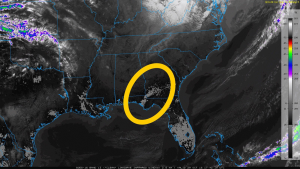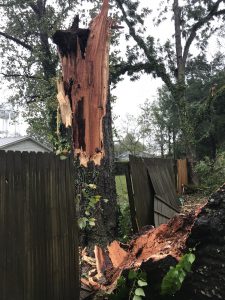After a devastating windstorm, as we just experienced in the Panhandle with Hurricane Michael, people have a tendency to become unenamored with landscape trees. It is easy to see why when homes are halved by massive, broken pine trees; pecan trunks have split and splayed, covering entire lawns; wide-spreading elms were entirely uprooted, leaving a crater in the yard. However, in these times, I would caution you not to rush to judgement, cut and remove all trees from your landscape. On the contrary, I’d encourage you, once the cleanup is over and damaged trees rehabilitated or disposed of, to get out and replant your landscape with quality, wind-resistant trees.
First, it’s helpful to take a step back and remember why we plant and enjoy trees and the important role they play in our lives. Beyond the commercial aspect of farmed timber, there are many reasons to be judicious with the chainsaw in the landscape and to plant anew where seemingly sturdy trees once stood. For example, trees provide enormous service to homes and landscapes, from massive cooling effects to aesthetic appeal. Take this thermal satellite image of Hurricane Michael’s path that simultaneously shows the devastation of a major hurricane and the role trees play in the environment.
In the lighter colored areas where the wind was strongest and catastrophic tree damage occurred, the ground temperatures are much higher than the unaffected areas. Lack of plant life is entirely to blame. Plants, especially trees, provide enormous shading effects on the ground that moderate ground temperatures and the process of transpiration releases water vapor, cooling the ambient air. Trees also lend natural beauty to neighborhood settings. There is a reason people termed the hardest hit areas by Michael “hellscapes”, “warzones”, etc. Those descriptions imply a lack of vegetation due to harsh conditions. In this respect, trees soften the landscape with their foliage colors and textures, create architecture with their height and shape, and screen people from noise, unpleasant sights and harsh heat.
Though all trees give us the benefits outlined above, research conducted by the University of Florida over a span of ten major hurricanes, from Andrew to Katrina, shows that some trees are far more resistant to wind than others and fare much better in hurricanes. In North Florida, the trees that most consistently survived hurricanes with the least amount of structural damage were Live Oaks, Cypresses, Crape Myrtle, American Holly, Southern Magnolia, Red Maple, Black Gum, Sycamore, Cabbage Palm and a smattering of small landscape trees like Dogwood, Fringe Tree, Persimmons, and Vitex. If one thinks about these trees’ growth habits, broad resistance to disease/decay, and native range, that they are storm survivors comes as no surprise. Consider Live Oak. This species originated along the coastal plain of the Southeastern United States and have endured hurricanes here for several millennia. Possessing unusually strong wood, they have also developed the ability to shed the majority of their leaves at the onset of storms. This defense mechanism leaves a bare appearance in the aftermath but allows the tree to mostly avoid the “umbrella” effect other wide crowned trees experience during storms and retain the ability to bounce back quickly. Consider another resistant species, Bald Cypress. In addition to having a strong, straight trunk and dense root system, the leaves of Bald Cypress are fine and featherlike. This leaf structure prevents wind from catching in the crown. Each of the other listed species possess similar unique features that allow them to survive hurricanes and recover much more quickly than other, less adapted species.
However, many widely grown native trees and exotic species simply do not hold up well in tropical cyclones and other wind events. Pine species, despite being native to the Coastal South, are very susceptible to storm damage. The combination of high winds and beating rains loosens the soil around roots, adds tremendous water weight to the crown high off the ground, and puts the long, slender trunks under immense pressure. That combination proves deadly during a major hurricane as trees either uproot or break at weak points along the trunk. In addition to pines, other widely grown native species (such as Pecan, Laurel Oak and Water Oak) and exotic species (such as Chinese Elm) perform poorly in storms. Just as the trees that survive storms well possess similar features, so do these poor performers. We’ve already mentioned why pines and hurricanes don’t mix well. Pecan, Laurel Oak, and Water Oak tend to have weak branch angles and break up structurally in wind events. The broad spreading, heavy canopy of trees like Chinese Elm cause them to uproot and topple over. It would be advisable when replanting the landscape, to steer clear of these species or at least site them a good distance from important structures.
This piece is not a warning to condemn planting trees in the landscape; rather it is a template to guide you when selecting trees to replant. Many of our deepest memories involve trees, whether you first climbed one in your grandparent’s yard, fished under one around a farm pond, or carved your initials into one in the forest. Don’t become frustrated after a once in a lifetime storm and refuse to replant your landscape or your forest and deprive your children of those experiences. As sage investor Warren Buffett once wisely said, “Someone is sitting in the shade today because someone planted a tree a long time ago.”
For these and other recommendations about how to “hurricane-proof” your landscape, contact your local UF/IFAS Extension Office. Plant a tree today.
- Feeling Blue (Ginger) This Fall - November 13, 2025
- Lawn Care When It Just Won’t Rain - September 11, 2025
- A Plea for Purple Heart - July 31, 2025


